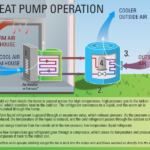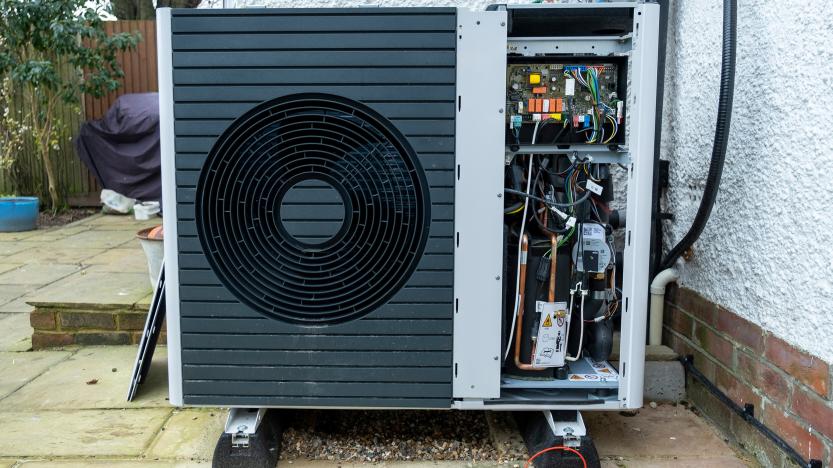This Google X spin-off backed by Bill Gates is offering a pathway to heat and cool your home with clean energy – CNBC
Energy Disrupter

Kathy Hannun wants to help reduce greenhouse gas emissions by making geothermal heat pumps mainstream.
Hannun, 34, spent seven years working at Alphabet’s X lab (formerly Google X), known as the tech giant’s “moonshot factory.” She helped launch several projects, like Project Loon, more than one of which were shut down because they were deemed not commercially viable.
The experience taught Hannun that she wanted to focus her energy on ambitious innovations that are ready to be scaled and brought to market. It led her to geothermal heat pumps, which she started working on at X with a project called Tiny Lime.
In 2017, Hannun and another X colleague, James Quazi, spun out Tiny Lime into start-up, Dandelion Energy. In February, Dandelion announced it has raised $30 million in a funding round led by Breakthrough Energy Ventures, the clean energy investment fund started by Bill Gates which includes money from Jeff Bezos, Michael Bloomberg, Ray Dalio, and others.
Now Hannun and Dandelion are working to take geothermal heat pumps, an energy-saving way of heating and cooling homes, mainstream. They are doing this by making it easier and cheaper for people to have geothermal heat pumps installed in their homes, allowing homeowners to move on from furnace systems that rely on oil, natural gas and propane.
Kathy Hannun is holding up a vial containing methanol made from carbon dioxide extracted from seawater combined with hydrogen made with the prototype Google X Project Foghorn machine.
Photo Courtesy Google X
Why geothermal heat pumps?
Geothermal heat pumps heat and cool indoor spaces in a more energy efficient manner than other heating and cooling systems. They can also be operated with electricity, offering a pathway to heating and cooling internal spaces with clean energy.
Geothermal heat pumps work by using an underground pipe system to move heat between the earth and your home. They are used for both heating and cooling — fluid running through the pipes picks up heat from the ground in the winter and deposits excess heat in the summer.
While geothermal heat pumps use energy to operate, the energy they use to operate is less than is used by non-geothermal systems (exactly how much varies). These pumps can use renewable, carbon-free energy, like solar or wind.
“Geothermal heat pumps are part of the pathway to zero [greenhouse gasses],” says Forrest Meggers, a professor of architecture at Princeton University and founder of Cooling and Heating for Architecturally Optimized Systems Lab.
Geothermal heat pumps also have the potential, with the addition of thermal or battery storage, to store heating and cooling energy for a home to draw on at a later time, which could help “decouple home thermal demand from energy demand,” Megger says. That means the potential to put less strain on energy grids — something that could have benefitted Texas during the blackouts caused by the cold spell in February. (Dandelion Energy does not currently add battery storage as an option.)
Other selling points for heat pumps include saving money on monthly fuel bills, quieter and more steady indoor heating and cooling, and they do not run the risk of causing carbon monoxide poisoning, according to Dandelion.
The Dandelion solution
Geothermal heat pumps are not new: There were an estimated 700,000 geothermal heat pumps in use in 2020, out of a total 123.4 million single, multi-family and mobile homes, according to the U.S. Energy Information Administration.
That number is not larger in part because replacing heating and cooling systems often has been a logistical headache as well as expensive.
With innovation, there’s “a large growth potential,” says Jasmin Raymond, a professor at Canada’s Institut National de la Recherche Scientifique (INRS), who has a specialty in geothermics and is the Scientific leader of the Geothermal Open Laboratory. “Solving such challenge will make geothermal more and more mainstream.”
That’s where Dandelion Energy comes in. The start-up’s goal is to be cheaper and more user friendly than the competition.
“None of the players in the U.S. had the capital or resources to really invest in pushing the technology forward, really productizing it and making it into a great customer experience — simple and easy and inexpensive,” Hannun tells CNBC Make It.
What Hannun and her co-founders created at X improved the drilling technology necessary for doing home retrofits. (Dandelion’s co-founders own the patents in exchange for Google being a shareholder.) As a result, Dandelion has smaller drilling equipment, which allows the company to take on projects that would be impossible with larger, conventional rigs.
“About half of the customers we serve today…their yards are too small and the conventional rig simply can’t access the yard,” Hannun says. Dandelion’s rig is also less disruptive and messy than conventional rigs, “which is very important for drilling in suburban neighborhoods,” she says.
To keep costs down, Dandelion Energy is also vertically integrated, meaning all parts of an installation are completed by Dandelion, from manufacturing its own heat pumps to installation (instead of relying on sub-contractors).
A typical Dandelion installation costs between $18,000 and $25,000 for an average sized home of about 2,000 square feet. (Direct comparisons are hard, but multiple homes of approximately 2,000 square feet paid about $50,000 for heat pump retrofits in Massachusetts between 2015 and 2019, according to public data, though that total is before federal tax credits were factored in.)
Dandelion, which operates in New York and Connecticut currently, allows its customers to pay for installation in installments, starting at $150 a month. The company also walks homeowners through the process of applying for federal and state-level tax incentives, which can “save Dandelion customers thousands of dollars,” the company’s website says.
It’s worth noting that Dandelion is still more expensive than legacy furnace heating systems when it comes to an upfront installation cost. Furnace installation can amount to a rough average estimate of about $8,000, according to HVAC.com, and central air conditioning installation costs an average of $5,638, according to HomeAdvisor.
However, recurring fuel costs are eliminated with a geothermal heat pump. The U.S. Energy Information Administration estimates fuel can average between $600 to $1,200 per winter, depending on the kind of fuel a customer uses.
While geothermal heat pumps can be installed in any kind of building (St. Patrick’s Cathedral on Fifth Avenue in Manhattan has a geothermal heat pump system, Hannun points out), Dandelion is currently focused on single-family homes.
“As a start-up…the single family home in upstate New York is an easier project to sell and manage and deliver on than a giant apartment building in New York City,” Hannun says. But as Dandelion grows, so will its menu.
A green future for geothermal heat pumps
Original Source: https://www.cnbc.com/2021/03/17/dandelion-energy-offers-pathway-to-heat-cool-home-with-clean-energy.html















